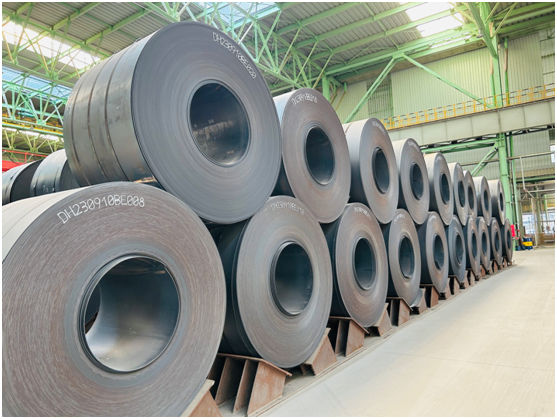Hot rolled coil, as a shining pearl in the steel industry, plays a pivotal role in the manufacturing industry with its unique process characteristics and wide application fields. It uses slabs as the main raw material, and after a series of complex processes such as heating, rough rolling, and finish rolling, it finally becomes a steel product with high strength and good toughness. This article will deeply explore the production process, performance characteristics and applications of hot rolled coils in various fields.

In short, the production process of hot rolled coils is to refine raw materials such as iron ore and coal into slabs through blast furnaces or electric furnaces, and then send these hot slabs to rough rolling mills and finishing mills for multiple rolling. The hot steel strip coming out of the finishing mill is cooled to the set temperature by laminar flow, and then rolled into a steel strip coil by a coiler. This is the birth of the hot rolled coil. According to the different needs of users, the cooled steel strip coil will also go through finishing lines such as flattening, straightening, cross-cutting or longitudinal cutting, inspection, weighing and packaging to be processed into steel plates, flat coils and slit steel strip products.
Hot-rolled coils are widely favored due to their excellent performance characteristics. It has high strength and can withstand large external forces without breaking easily; it has good toughness and is easy to process and shape to meet the needs of various complex shapes; at the same time, it also has good weldability, allowing easy connection during the manufacturing process. These excellent properties make hot-rolled coil the preferred material for many manufacturing industries such as ships, automobiles, bridges, construction, machinery and pressure vessels.
In the field of shipbuilding, hot-rolled coils are widely used in the construction of hull structures due to their high strength and good toughness, ensuring the safety and durability of ships. In the automotive industry, hot-rolled coils have become an important raw material for car bodies, chassis and other parts due to their easy processing and weldability. In addition, in the fields of bridges and construction, hot-rolled coils are also widely used in key parts such as bridge supporting structures and building skeletons due to their stable mechanical properties and good corrosion resistance.
It is worth mentioning that with the continuous advancement of hot-rolled coil technology, new control technologies such as dimensional accuracy, plate shape and surface quality of hot-rolled coils are becoming more and more mature, making their application areas more extensive. At the same time, the continuous development of the hot-rolled coil futures market has also provided manufacturing companies with effective price risk management tools, further promoting the prosperity of the hot-rolled coil market.
However, the production process of hot-rolled coils is not always smooth. It needs to go through multiple rolling and cooling processes, and has extremely high requirements on equipment and processes. At the same time, in order to meet the needs of different users, various finishing operations are required, which undoubtedly increases production costs and time costs. But despite this, hot-rolled coil still maintains strong market competitiveness due to its excellent performance and wide range of applications.
In summary, as an important product in the steel industry, hot-rolled coil plays an irreplaceable role in the manufacturing industry with its unique process characteristics and wide application fields. In the future, with the continuous advancement of technology and the continuous expansion of the market, the application prospects of hot-rolled coil will be broader.
